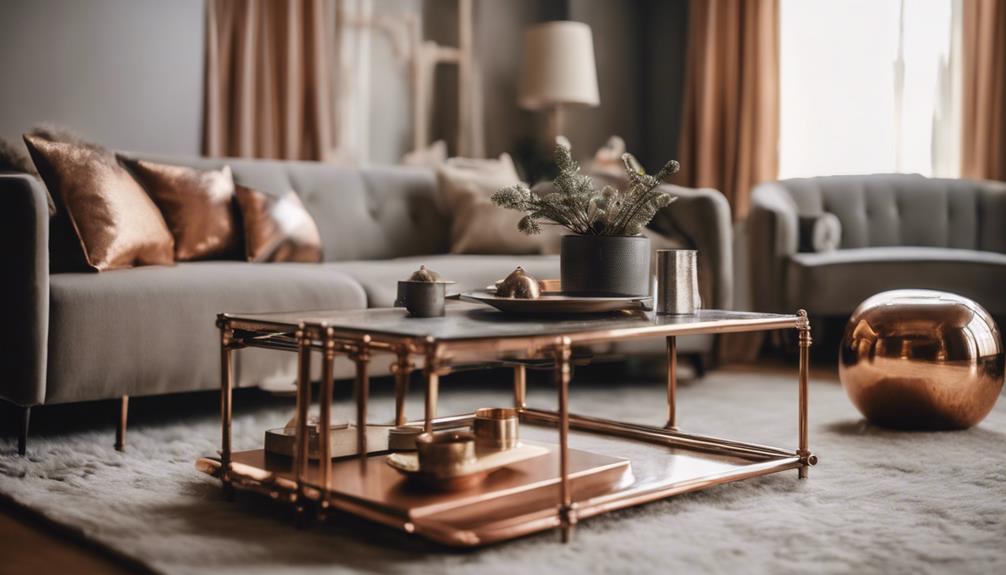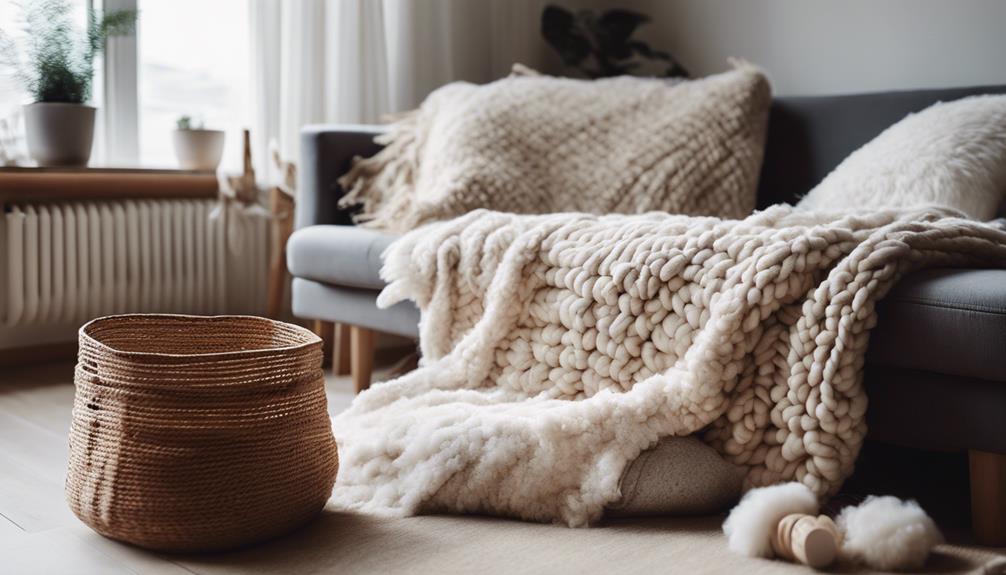Mixing different metals in your home decor can create a sense of depth, texture, and visual interest while still achieving a cohesive design. It’s helpful to choose a primary metal for each room to establish a consistent look. Combining warm tones can help create a harmonious atmosphere, and it’s recommended to limit the number of finishes to two or three for a balanced finish. To avoid clashing, steer clear of mixing metals with similar colors and finishes – instead, aim for a blend that offers contrast and harmony. Experiment with brass, nickel, black, and stainless steel for a chic mix. Distribute the metals evenly throughout the space for a sense of equilibrium. Successful metal mixing involves playing with different finishes, textures, consistent color schemes, and adding a touch of natural iron for a grounding effect. For more tips on harmoniously mixing metals, explore further here.
Key Takeaways
- Mixing metals in home decor is encouraged for texture and dimension.
- Blending different finishes adds visual interest and depth to the design.
- Cohesive color palette and dominant metal selection anchor the space.
- Limiting metal finishes to two or three maintains balance and harmony.
- Experimenting with textures and considering undertones ensures a harmonious blend.
Benefits of Mixing Metals in Decor
Mixing metals in home decor enhances the visual appeal and depth of interior spaces. When it comes to metals, the finishes play a significant role in creating a dynamic and visually appealing atmosphere. By blending different finishes, such as matte, polished, or brushed, you can add texture and dimension to your decor. It's crucial to take into account the overall color palette of the room to guarantee a cohesive look. Selecting a dominant metal to anchor the space and incorporating complementary accents can enhance the design cohesion.
The combination of metals not only adds visual interest but also brings character to the decor. Mixing metals allows you to create a cohesive look that's visually engaging. By carefully selecting and blending different metals, you can achieve a harmonious balance that elevates the style of your space. Experimenting with mixing metals can help you achieve a unique and personalized look that reflects your taste and personality.
Guidelines for Mixing Metals Harmoniously

To achieve a harmonious blend of metals in home decor, it's important to carefully select a dominant metal for each room to anchor the design aesthetic. When mixing metals, consider incorporating warm undertones to create a cohesive and inviting atmosphere.
Limiting the use of different metal finishes to two or three within a space helps maintain a sense of balance and visual appeal. Experimenting with various textures such as matte, polished, or hammered can add depth and richness to the overall design.
It's vital to keep in mind the room's color palette when selecting metal finishes to make sure they complement each other seamlessly. Pay attention to the hardware in the room as well, as it can serve as a unifying element when considering mixing metals.
Common Mistakes to Avoid When Mixing Metals

When blending metals in home decor, it's crucial to steer clear of mixing metals that are too similar in color and finish. To avoid overmixing and create a cohesive look, aim to incorporate contrasting tones and finishes. Pay close attention to undertones to guarantee harmony throughout your space. Limiting yourself to one to three metals can help maintain consistency and prevent a cluttered or chaotic appearance. Here's a quick reference table to help you navigate the dos and don'ts of mixing metals effectively:
| Do's | Don'ts |
|---|---|
| Mix contrasting tones | Mix metals with similar finishes |
| Pay attention to undertones | Overmix metals |
| Stick to one to three metals | Neglect consistency in finishes |
| Aim for visual interest | Forget about harmony |
Creative Ways to Incorporate Mixed Metals

Incorporating mixed metals creatively can elevate the aesthetic appeal of your home decor effortlessly. By combining metals like brass, nickel, black, and stainless, you can achieve a sophisticated and stylish look. When mixing metals, consider the warm undertones and overall color palette of your space to guarantee a harmonious blend. Choose a dominant finish to anchor your design and use accent metals to complement it effectively. This strategy creates visual interest and adds depth to your interior decor.
To incorporate mixed metals creatively, distribute them evenly throughout the room. Whether through light fixtures, hardware, or decorative accents, spreading the metals will maintain balance and harmony in your design. The contrast of different finishes will create a dynamic and curated look, adding character to your space. Embrace the versatility of mixed metals to achieve a unique and personalized style that showcases your eye for design.
Examples of Successful Metal Mixing in Decor

Exploring various textures and finishes through mixed metals can result in a visually engaging and dynamic home decor scheme. When blending metals in decor, it's important to think about contrasting finishes to create visual interest and add depth to your interior spaces.
Texture also plays a vital role in achieving a visually rich atmosphere; combining smooth and rough surfaces can enhance the overall look. Additionally, paying attention to the color palette is necessary for a cohesive design – harmonizing the tones of different metals can tie the room together seamlessly.
Introducing natural iron elements can help ground or tone down a metallic palette, adding a touch of warmth and earthiness to the space. By carefully balancing these elements, you can create a unique and inviting ambiance that showcases your personal style while adding character to your home decor.
- Mixing metals for depth and character
- Contrasting finishes for visual interest
- Texture for a visually rich atmosphere
- Considering the color palette for cohesion
- Using natural iron to ground the metallic palette
Frequently Asked Questions
Is It OK to Mix Metals in Interior Design?
Mixing metals in interior design is a great way to add depth and character to a space. Choose a dominant metal for cohesion and mix in complementary accents. Consider color palettes, undertones, and finishes when combining metals.
Limit the number of different finishes for balance. Experiment with various metal combinations, textures, and sheens for visual interest. It's acceptable and can enhance the overall look of your home decor.
Is It Okay to Mix Gold and Silver Decor?
Mixing gold and silver decor can indeed create a striking contrast in home design. By strategically choosing one metal as the dominant player and the other as a supporting accent, you can achieve a harmonious blend. Pay attention to the undertones of each metal to make sure they complement rather than clash.
Experimenting with different textures and finishes can also add depth and visual appeal to your space. The key is finding the right balance that suits your personal style preferences.
How Many Metals Can You Mix in a House?
We can mix 2-3 different metals in a house for a visually appealing look. Limiting the number of metals maintains balance and harmony. Subtle mixing guarantees a sophisticated aesthetic.
Starting with a dominant metal and accentuating with others creates a well-balanced space. Distributing the metals evenly throughout the house helps create a cohesive design. Mixing metals adds visual interest without overwhelming the overall look of the home.
What Metals Mix Well Together?
When considering metal combinations in home decor, one must choose metals that complement each other. Brass and bronze blend well due to their distinct appearances and warm tones.
Satin nickel and polished brass offer a striking contrast for a deliberate aesthetic. Mixing warm metals like brass, gold, and copper can create a cohesive look.
For cooler tones, stainless steel and chrome make a sleek pair. Don't hesitate to experiment with matte black alongside warm metals for a versatile touch.
Conclusion
To sum up, mixing metals in home decor can add depth and visual interest to your space. By following guidelines and avoiding common mistakes, you can create a harmonious and stylish look.
Get creative with incorporating mixed metals in your decor for a unique and personalized touch. Stay tuned for more tips and inspiration on how to elevate your home decor with this versatile design trend.










